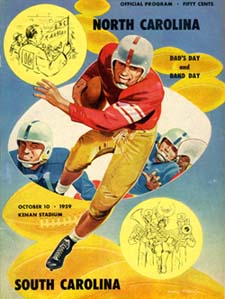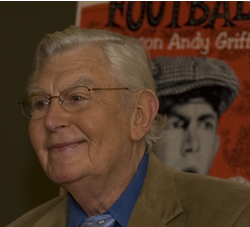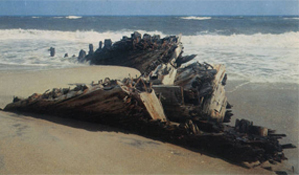Our 51st edition of “This Month in North Carolina History” examines a January 1961 airborne alert mission gone awry. Read about it at “Bombs Over Goldsboro.”
Jason Tomberlin
The G. A. Kohler
A 1933 hurricane pushed the G. A. Kohler, a four-masted schooner from Baltimore, ashore just north of Cape Hatteras. The wreck remained on the coast until World War II, when the wooden ship was burned in an effort to recover scrap iron from her hull. The image of the intact ship was made sometime between the wreck and 1945.
<img src='https://blogs.lib.unc.edu/ncm/wp-content/uploads/sites/6/2007/11/kohler_together.jpg' alt='kohler_together.jpg' align="center" vspace="8" hspace="14"
The color image, which comes from a postcard in the Durwood Barbour Collection, is not dated but is thought to have been created in the 1950s or 1960s.
Jack and the Giant, North Carolina Style
I’m pretty sure that “Jack and the Beanstalk” is an English fairy tale, but the location of the story may have to be changed to western North Carolina. On September 1st of this year, Boone-based Appalachian State University shocked the college football world by upsetting perennial powerhouse Michigan…in “The Big House,” no less. Not to be outdone, on November 7, the Boiling Springs-based Gardner-Webb University men’s basketball team went to Rupp Arena and soundly defeated Kentucky, which not only has seven national championships to its name but also has more all-time wins than any other Division I program.
Will The Real Carolina Please Step Forward?

Let me go ahead and get this out of the way. I am biased. While I was born in Tennessee (once a part of the real Carolina), I’ve lived in North Carolina for 27 wonderful years and I graduated from the University of North Carolina. In my early teens, I spent one horrible year living in the lesser carolina.
Leading up to this Saturday’s football game between the Tar Heels and the Gamecocks, I’ve read several articles discussing which university can legitimately be called “Carolina.” I’ve heard it all before, and I don’t think any of the arguments have convincingly settled the debate. So I decided to get the opinion of two “experts”: Google and Wikipedia.
I entered the search term “Carolina” into both web sites and discovered that neither university was the first result returned. On Google, the University of North Carolina was the third result, ranking ten spots higher than our counterparts in Columbia. On Wikipedia’s disambiguation page, UNC was listed just above USC, scoring another win for the Tar Heels.
In a world increasingly dominated by Google and Wikipedia, I think I have finally found proof that I root for the one and only Carolina.
Mayberry, Thelma Lou’s Home Town, Too
CNN’s website recently reported that Betty Lynn, the actress that played Barney Fife’s girlfriend Thelma Lou, has moved to Mount Airy, North Carolina. Finding that she was tired of Hollywood, Ms. Lynn decided that there was “NO place like [Mount Airy], unless it’s heaven.”
October 1960: The Andy Griffith Show
This Month in North Carolina History

“Anybody here know why these two should not be wed, speak now or forever hold your peace.”
With this opening line, a pop-culture phenomenon was born on October 3, 1960, at 9:30 p.m. when The Andy Griffith Show premiered. The show starred Andy Griffith, a North Carolina native and graduate of the University of North Carolina, who had risen to national fame with the comic monologue, What It Was Was Football, and a starring role in the stage and film version of No Time For Sergeants.
The series pilot aired on February 15, 1960, and was actually an episode of The Danny Thomas Show. It introduced viewers to Sheriff Andy Taylor, played by Griffith, and the fictional town of Mayberry, North Carolina, which is widely believed to be based on Griffith’s hometown of Mount Airy, North Carolina—although he has often denied it. The following October the series officially began with an installment titled “The New Housekeeper.” The show opened with Andy’s former housekeeper, Rose, getting married and moving away. Andy then asks Aunt Bee, who helped raise him, to assist in taking care of his son, Opie. Although he adamantly opposes Aunt Bee in the beginning—she can’t fish, catch frogs, or play baseball like Rose—Opie ends up accepting her into the household, fearing that she can not survive in a world with such limited skills. This episode also introduced viewers to Deputy Barney Fife, Sheriff Taylor’s comically inept sidekick.
Although The Andy Griffith Show remains one of the most popular television series of all time, it was initially disparaged by several media commentators. A review in the October 4, 1960 New York Times commented that the show was “only mildly entertaining.” Jack Elinson, a script writer during the first two seasons, remarked that the show was not “treated too kindly by the critics out here, the hip Hollywood people” and that the “cast and everybody was just a little glum.” On October 6, in the “Goings On” section of the Raleigh News and Observer, Raymond Lowery wrote that the reviews from the New York papers “weren’t good,” but that “they weren’t all bad” and that the “gentle, relaxed, family-type series would bear watching [and] that it had possibilities which may be realized later.”
What several reviewers disliked, however, countless television viewers loved. Elinson went on to say that the cast and crew calmed down and cheered up when they received the show’s “through the roof” Nielsen Ratings. Other commentators began to notice the show’s popularity as well. On October 16, 1960, only 13 days after the series’ debut, writer Earl Wilson observed that Andy Griffith was already “a big TV star.” One year later, at the beginning of the show’s second season, a Newsweek article noted Griffith’s “strangely popular situation comedy.” The show’s status only increased during its eight-year run, and it even garnered the Nielsen Rating’s number-one ranking in its final season. In the almost forty years since the last episode, The Andy Griffith Show continues to appeal to countless fans, and it remains as one of the most well-liked television series in American history.
Sources
Ken Beck and Jim Clark. Mayberry Memories: The Andy Griffith Show Photo Album. Nashville, Tenn.: Rutledge Hill Press, 2000.
Lee Pfeiffer. The Official Andy Griffith Show Scrapbook. Secaucus, N.J.: Carol Pub. Group, 1994.
Dale Robinson and David Fernandes. The Definitive Andy Griffith Show Reference: Episode-by-Episode, With Cast and Production Biographies and a Guide to Collectibles. Jefferson, N.C.: McFarland, 1996.
Earl Wilson. “Barbara Cries With Andy’s Happiness.” The News and Observer (Raleigh, N.C.), 16 October 1960.
Raymond Lowery. “Goings On.” The News and Observer (Raleigh, N.C.), 6 October 1960.
“Andy Griffith Show,” New York Times, October 4, 1960.
Mayberry, Our Home Town
It happened at 9:30 p.m. on October 3, 1960 . . . the first episode of The Andy Griffith Show. In the 47 years since that night, the show has remained one of America’s all-time favorites. Read more about the debut and the initial reaction to it on the North Carolina Collection’s “This Month in North Carolina History.“
June Bug Town

Here at the North Carolina Collection we take pride in knowing all things “North Carolina.” You may be able to stump one of us, but when we put our collective heads together and do a little digging, we can generally find the answer to most North Carolina-related inquiries…that is, until we ran into the bug. One of our catalogers found a thoroughfare plan for Taylorsville (Alexander County), North Carolina, and we were stumped by the town’s seal. Normally, these emblems include items related to the town’s history, commerce, or location, but why (oh why) did Taylorsville have a bug in the middle of its seal?
After a thorough search of our collection, we finally gave up and called the Town of Taylorsville. After a brief chuckle, the person on the other end of the line explained that the insect commemorates the “June Bug Line,” a railroad to Taylorsville that was completed in 1887. During the debate over the railroad’s charter, an Alexander County legislator, arguing for its completion, supposedly said, “Gentleman, there’s a mine in Hiddenite with a mineral so precious that a June Bug could fly away with enough on its wings to pay for the whole railroad.” The gems may not have stuck to the bug’s wings, but the railroad’s name did.
A Dip in the “Cool Pool”
I don’t know about where you are, but here in Chapel Hill it’s hot. With a forecast high of 97 degrees and a heat index of around 105 degrees, I was trying to think of something “cool” to do this afternoon. If I were in Tarboro in the 1930s, I definitely know what I would do; I’d take a dip in the “Cool Pool.”
According to an entry written by Jaqueline Drane Nash in the recently published Encyclopedia of North Carolina, the Cool Pool came about after the Tarboro Town Council asked a Pennsylvania firm to install a refrigerating unit for the town pool. For a mere $2592, the residents of Tarboro enjoyed what “is believed to have been the first and perhaps only refrigerated outdoor pool in the country.” Now that is what I call North Carolina ingenuity (with a little help from Pennsylvania).
The Peak of Good Living
Here at the North Carolina Collection we love talking and writing about North Carolina superlatives. Yesterday I noticed one that hit close to home–real close to home. The town in which I live, Apex, North Carolina, was named by Money Magazine as the 14th best place to live in the United States, garnering the highest rating for any North Carolina town.
The compilers of the Best Places to Live: Top 100 state that this year’s list “focused on smaller places that offered the best combination of economic opportunity, good schools, safe streets, things to do and a real sense of community.” As a way of quantifying how much “Leisure and Culture” Apex has, the magazine figured out that there were 1,598 restaurants and 122 bars within 15 miles of the town. Wow, I really need to get out more.
The other North Carolina towns that made the list are Holly Springs (Wake County) at No. 22 and Mooresville (Iredell County) at No. 65.

